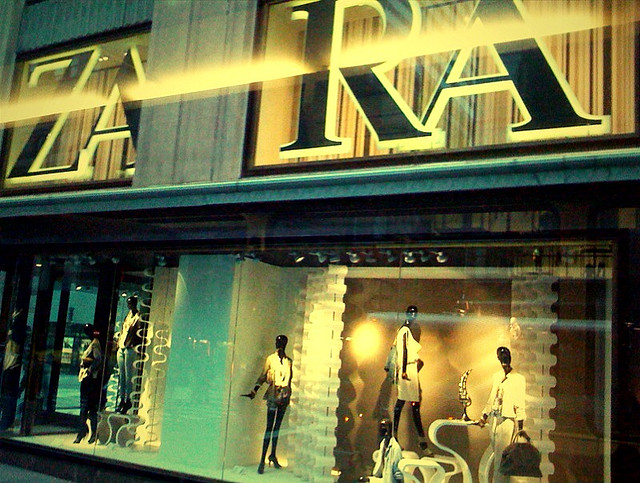Fashion has been in the news a lot lately, and not in the obvious place, the Style section: instead, major American retailers are making the front page of the Business pages. This weekend, The New York Times ran another feature on the decline of Gap, following a devastating (for me at least) reveal of widespread financial declines and customer disappointments at J.Crew. These stories emphasize how these once-high-quality, emblematic brands have lost their groove: shoppers find their styles unappealing and made in a way that’s not worth the high-two- and three-digit prices tags, even to the extent that one can be turned off from the shopping experience all together. Instead, trendy, inexpensive stores like Zara, H&M, Uniqlo, and Forever 21 are climbing the customer satisfaction and profit charts. These brands offer up-to-the-minute designs at a fraction of real designers’ prices, and although there’s more poly-blend than you’d think possible, the clothes are cheap enough that having to update and replace one’s wardrobe every season (or every week–hence the “fast” bit) is not only as fun as the runways say it should be, but also feasible to the average consumer.
Indeed, to the average consumer this turn toward wallet-friendly clothing and accessories seems like a godsend. But what are the larger implications of the fast-fashion moment we’re in? Think back six decades ago, when processed foods and margarine were all the rage: families could eat so much more without having it go bad, and the salty, sugary goodness tasted great, too! What’s not to love? For peaceful dumplings, the long-term dangers of eating a high-processed diet are our inner bible. Fast fashion is a similar road, one that if we follow for too long will one day result in much more ugliness than beauty.

Shopping in a fast fashion store can be intoxicating. Making the fast fashion products can be…toxic.
Fast fashion has been circulating in the news for the past year or so, and was even the subject of a documentary film released last month at the Cannes Film Festival called The True Cost. But with increasing financial proof of “slow” fashion’s plummeting stakes in the industry, now seems like a moment when conscious consumers can try to stand up to the trends by making purchases with integrity in mind: we must treat our clothing like we do our food, choosing quality and health over convenience or price whenever possible. Besides the obvious drawbacks of having cheaper-made clothing (my sister and I have a signal to warn each other against buying “sweat-inducing” polyester), consider these eye-opening facts before making your next fast fashion purchase:
1. Workers in textile factories overseas can make as little as $10 per month. Trendy items with lots of beads and embroidery means more labor involved for these individuals, most likely children, but not more compensation for their craft and work.
2. Fashion is the 2nd most polluting industry in the world. What’s #1? Oil. Think about it.
3. How can clothing be polluting the environment? A variety of chemicals like lead, formaldehyde, pesticides, and carcinogens are woven into the fabrics we put on our bodies; run-off from factories leaches back into the earth, in increasing amounts as demand rises (H&M increased its sales in the U.S. by $2 billion since 2000, whereas Gap’s fell roughly the same amount in the same time period), and long-term exposure can lead to health problems like infertility among female workers.
4. Also: fast fashion is designed to be replaced quickly, not so much by desire but by need. Clothing literally falls apart, meaning that it must be discarded rather than donated or sold to consignment shops. The volume of textile waste is staggering–Americans toss 68 pounds of clothes per year on average–and with that weight comes those nasty chemicals, which decompose at an even slower rate if at all.
The problem of fast fashion is particularly acute for vegans as there is an abundance of synthetic fabrics available from these retailers’ lines (save a cow and save money? A win-win!). But in the end, what are you really saving? The scales of suffering seem equal in both cases.
To come to terms with the dwindling options for stores and brands that don’t make me or my wallet feel bad, I’ve been trying to adopt the European outlook of less is more. I may have to (big sigh) spend more money on a dress made by a local designer from organic fabric with natural dyes, but it will probably last me a lot longer than an alternative in terms of durability and the style itself. And having a more curated closet means fewer things I only feel so-so about wearing, which makes dressing myself every day a tiny act of self-love.
How do you make conscious decisions when you shop? Share your favorite local stores, brands, and fabrics and together we can slow down the fashion industry for all our sakes.
Also by Jennifer: What I Learned from Eckhart Tolle’s The Power of Now
9 Amazing Benefits of Rhodiola + My Results
Get more like this–Subscribe to our daily inspirational newsletter for exclusive content!
__
Photo: urbanlatinfemale via Flickr; Fahad Faisal/Wikimedia Commons; Peaceful Dumpling






